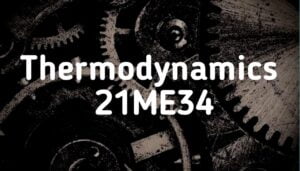
Thermodynamics 21ME34
Module 1`
Introduction and Review of fundamental concepts: Thermodynamic definition and scope, Microscopic and Macroscopic
approaches, Some practical applications of engineering thermodynamic Systems, Characteristics of system boundary and
control surface, examples. Thermodynamic properties; definition and units, intensive, extensive properties, specific
properties, pressure, specific volume Thermodynamic state, state point, state diagram, path and process, quasi-static
process, cyclic and non-cyclic; processes; Thermodynamic equilibrium; definition, mechanical equilibrium; diathermic
wall, thermal equilibrium, chemical equilibrium, (Only for Self study)
Zeroth law of thermodynamics. Temperature; scales, thermometry, Importance of temperature measuring instruments.
Design of Thermometers.
Work and Heat: Thermodynamic definition of work; examples, sign convention, Displacement work, Heat; definition,
units and sign convention, Expressions for displacement work and heat in various processes through p-v diagrams. Shaft
work, Electrical work.
First Law of Thermodynamics: Statement of the first law of thermodynamics, extension of the First law to non – cyclic
processes, energy, energy as a property, Steady Flow Energy Equation (SFEE) and engineering applications.
Module 2
Second Law of Thermodynamics and Entropy: Limitations of first law of thermodynamics. Devices converting heat to
work; (a) In a thermodynamic cycle, (b) In a mechanical cycle. Thermal reservoir, direct heat engine; schematic
representation and efficiency. Kelvin – Planck statement of the Second law of Thermodynamics; PMM I and PMM II,
Clausius statement of Second law of Thermodynamics, Carnot cycle, Clausius inequality, Statement-proof, Entropydefinition,
a property, change of entropy, entropy as a quantitative test for irreversibility, entropy as a coordinate.
Available energy and Exergy: Available energy, Maximum work in a reversible process; useful work; Dead state;
availability; Second law efficiency.
Module 3
Introduction and Review of Ideal and Real gases: Ideal gas mixtures, Daltons law of partial pressures, Amagats
law of additive volumes, Evaluation of properties of ideal gases. Real gases: introduction, Van-Der Waal’s
equation, Van-Der Waal’s constants in terms of critical properties. (Only for self study)
Compressibility factor, compressibility chart and applications.
Thermodynamic relations: Maxwell’s equations, TdS equation. Ratio of Heat capacities and Energy equation,
Joule-Kelvin effect, Clausius-Clapeyron equation.
Combustion thermodynamics: Theoretical (Stoichiometric) air for combustion of fuels, excess air, actual
combustion. Exhaust gas analysis. A/F ratio, energy balance for a chemical reaction, enthalpy of formation,
enthalpy and internal energy of combustion, adiabatic flame temperature, combustion efficiency.
Module 4
Pure Substances: P-T and P-V diagrams, triple point and critical points, sub-cooled liquid, saturated liquid, mixture of
saturated liquid and vapour, saturated vapour and superheated vapour states of pure substance with water as example.
Enthalpy of change of phase (Latent heat), Dryness fraction (quality) representation of various processes on T-S & H-S
diagrams.
Vapour Power Cycles: Carnot vapour power cycle, simple Rankine cycle, actual vapour power cycles, ideal and practical
regenerative Rankine cycles, open and closed feed water heaters, Reheat Rankine cycle and characteristics of an Ideal
working fluid in vapour power cycles.
Module 5
Gas power cycles
Ericson Cycle, Stirling Cycle, Air standard cycles-Otto cycle, Diesel cycle and Dual cycle, computation of thermal efficiency
and mean effective pressure, comparison of Otto, Diesel & Dual cycles.
Gas turbine Cycles: Introduction and classification of gas turbine, gas turbine (Brayton) cycle; description and thermal
analysis and methods to improve thermal efficiency of gas turbines, Jet Propulsion.